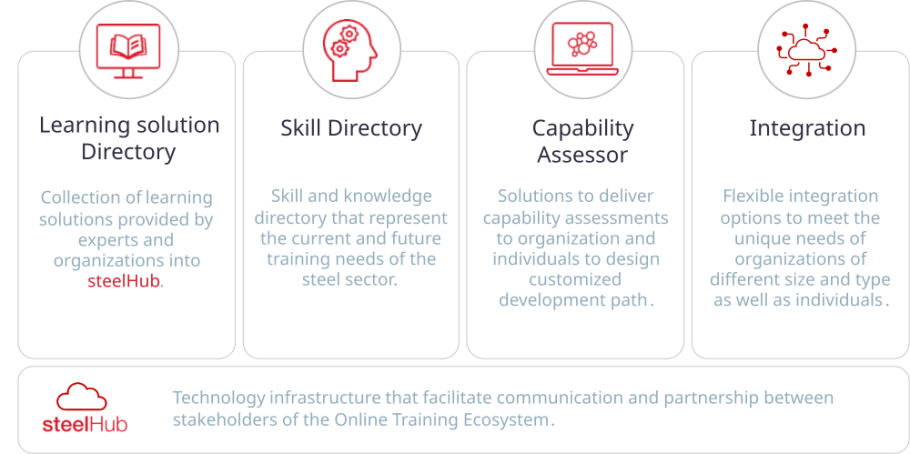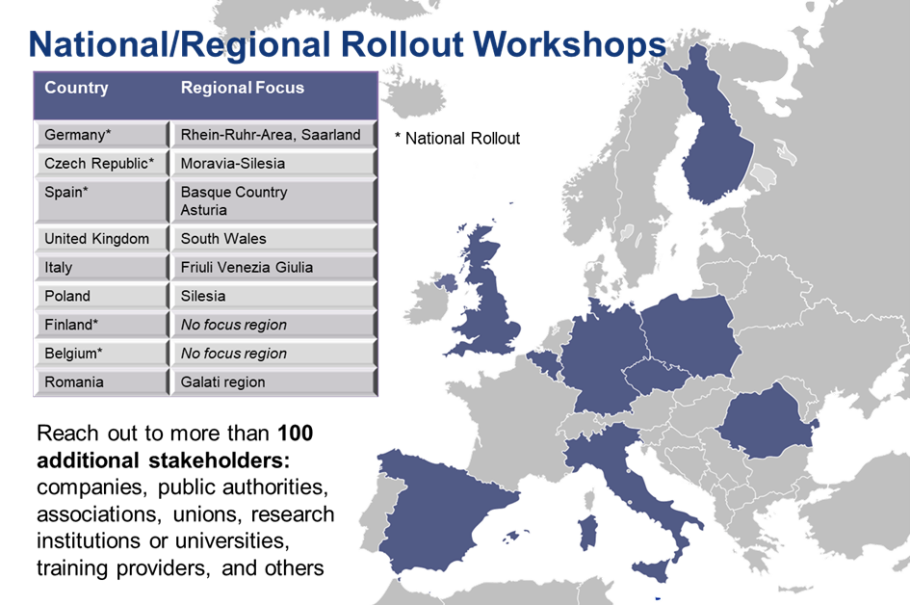
The steelHub is a digital online platform (accessible via https://hub.steeluniversity.org/) that serves as a central hub for the distributing and exchanging training content relevant to the steel industry. As a not-for-profit online training ecosystem it brings together different types of stakeholders (companies, associations, training providers) and fosters their collaboration.
The platform presents a comprehensive collection of modern digital learning solutions (Learning solution directory), including e-learning, webinars, certifications, cognitive assessments / exams, videos, interactive 3D models, simulations and games. These resources will be further extended in the future using the ADDIE (Analysis, Design, Development, Implementation, Evaluation) model describing a flexible, systematic process for developing training programmes.

The platform also boasts a Skill Directory, a central repository of skills and knowledge that represents the current and future training need of the steel sector. Each learning solution is classified according to the Skills Directory. Furthermore, a Capability Assessor is included in the platform. The assessor is a self-assessment tool for organisations and individuals to identify educational / skills gaps. A further important feature of the steelHub is its flexibility, that allows an integration of the solutions provided into different types of organisations and individuals.
More information on the steelHub can be found in Deliverable D5.1 and Deliverable 5.3, chapter 3.4.1.
The steelHub (online training ecosystem) is complemented by a National-Regional Training Ecosystem (ESSA RTS) that focuses on the "real" place where people live, learn and work. Its main intention is not only to disseminate the Blueprint, but also to implement specific national-regional processes that are based on and supported by the ESSA Blueprint and its elements. The intention is to integrate the regional level in three dimensions: The pedagogical integration, i.e. new or better learning opportunities, the organisational integration, i.e. common administrational or directing structures, as well as regional integration, i.e. e.g. activities and projects which reflect local demands.
As a central method for initiating those National-Regional Training Ecosystems workshops were organised in a selection of nine European steel regions as a part of the regional roll-out activities of the ESSA project.

These reached more than 100 additional stakeholders such as education and training providers, different types of enterprises, governments and public authorities as well as civil society actors, taking advantage of the adaptability of the ESSA framework to concrete regional needs. This includes the involvement of the national level actors whenever this was appropriate to achieve the desired outcome.
For a detailed description of the national-regional rollout processes as well as the workshop results, see Deliverable 6.2, chapter 5.
The central starting point for initiating the Foresight Observatory was the lack of a systematic process for assessing and forecasting skills needs in the steel industry. The Foresight Observatory was designed to provide regular monitoring and evaluation of:
At the core of the ESSA Foresight Observatory a regular European Steel Technology and Skills Foresight Panel (Skills Radar) is conducted. The survey is a regular monitoring and assessment tool based on the results and methodological evaluation of two surveys already conducted during the implementation and testing phase of ESSA. The results are summarised in a Steel Technology and Skills Foresight Index, which will be further discussed in annual workshops of selected experts focussing on necessary implications for the steel industry concerning the main results of the survey.
In addition, the implementation and operation of the Blueprint at European level will be monitored within the Foresight Observatory. This will include:
Based on the results of the survey, the expert workshop and the monitoring, all other relevant activities will be continuously refined; e.g. training offers and learning arrangements, incentives as awards or online fora and policy recommendations.
More details on the Foresight Observatory can be found in Deliverable 5.3, chapter 3.1 as well Deliverable 3.2, chapter 2.2.
The steel industry must overcome a negative image, particularly among those people with no contact to the industry. Improving the steel industry’s image is crucial for attracting and retaining the needed talents for a high-skilled workforce. At the same time, new technological developments as well as the green transformation will create new job profiles in production, IT, cybersecurity, environmental sustainability and leadership.
Effective strategies for recruiting showcase the industry’s digital and green transformation and promoting the steel industry as a secure, long-term employer with multiple opportunities. But also, retaining young, skilled workers is essential for industry’s future. Companies must adapt to changing values and expectation to compete with other industries.
Central output of the ESSA project to contribute to these challenges is the ESSA Repository for Image and Recruitment Materials (Link). The repository includes:
The different measures are described in detail in Deliverable 5.3, chapter 3.4.
Based on the ESSA results and an analysis of the legislative framework of the European Union, specific policy recommendations have been formulated on different levels and for different stakeholders:
General Recommendations:
At the European Level:
At the National level:
At the Regional level:
Finally, recommendations related to SME support are:
The full recommendations can be found at Deliverable D7.1.
 |
Agreement Number: 2018-3059/001-001 Project Number: 600886-EPP-1-2018-1-DE-EPPKA2-SSA-B |